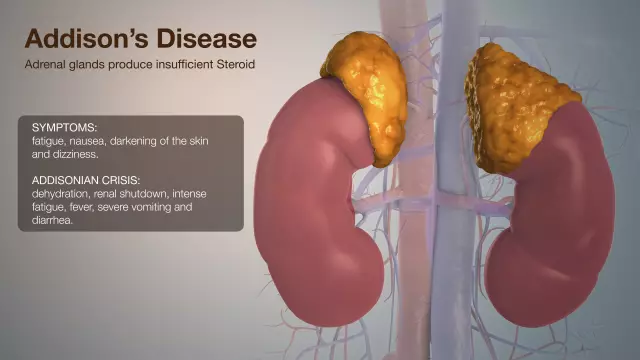- Author Rachel Wainwright [email protected].
- Public 2023-12-15 07:39.
- Last modified 2025-11-02 20:14.
Gastroesophageal reflux disease
The content of the article:
- Causes and risk factors
- Forms of the disease
- Symptoms
- Diagnostics
- Treatment
- Possible complications and consequences
- Forecast
- Prevention
Gastroesophageal reflux disease (GERD) is a chronic recurrent disease of the esophagus caused by the discharge of aggressive gastric or gastrointestinal contents into the esophageal lumen and is characterized by esophageal and extraesophageal symptoms.

Pathogenesis of gastroesophageal reflux disease
The true incidence of the disease is unknown, as the disease has a wide variety of symptoms. According to the results of some studies, in Russia, the carriers of the disease are 11-23% of the population, according to other data - up to 30%, the prevalence of GERD is compared with the prevalence of peptic ulcer and gallstone diseases.
Difficulties in making a diagnosis are associated with a number of reasons: first, the disease is often asymptomatic; secondly, even with pronounced subjective sensations, there may be no objective supporting data; third, symptoms similar to those of GERD can be physiological in nature and occur in healthy people.
GERD occurs in all age groups, in both sexes, including children; the incidence increases with age.
Synonyms: peptic esophagitis, reflux esophagitis.
Causes and risk factors
The main pathogenetic substrate for the development of gastroesophageal reflux disease is the actual gastroesophageal reflux, that is, the retrograde reflux of the stomach contents into the esophagus. Reflux most often develops due to the failure of the sphincter located at the border of the esophagus and stomach.
Normally, during swallowing movements, the muscle tone of the lower esophageal sphincter decreases, passing the food lump from the esophagus to the stomach, and after the passage of food, the sphincter closes.
Under the influence of various external and internal factors, hypo- or atony of the lower esophageal sphincter develops, which leads to a reverse reflux of aggressive gastric contents (reflux). Reflux causes damage to the mucous membrane of the esophagus, since the esophagus is characterized by a weakly acidic pH reaction (closer to neutral), and gastric juice has a sharply acidic pH reaction due to hydrochloric acid and proteolytic enzymes. Entering the esophagus, gastric juice causes a chemical burn of the mucous membrane.

What Happens With Gastroesophageal Reflux Disease
Factors that reduce the tone of the esophageal sphincter:
- taking certain medications (calcium antagonists, nitrates, antispasmodics, analgesics, theophyllines, etc.);
- the use of food products and medicines containing caffeine (tea, coffee, tonic drinks, Citramon preparations, Caffetin, etc.);
- eating peppermint and foods containing it;
- smoking;
- eating disorders;
- increased intra-abdominal pressure (constipation, inadequate physical activity, prolonged inclined position of the body, etc.);
- pathology of the vagus nerve (vagal neuropathy in diabetes mellitus, vagotomy);
- pregnancy.
Causes leading to episodes of spontaneous relaxation of the lower esophageal sphincter:
- dyskinesia of the esophagus (disturbances of peristalsis);
- swallowing a large amount of air while eating - aerophagia (provoked by a hasty, plentiful meal);
- flatulence;
- volumetric formations of the abdominal cavity and retroperitoneal space;
- gastroduodenal pathology [hernia of the esophageal opening of the diaphragm, peptic ulcer of the stomach and duodenum (most often - when the ulcer is localized in the bulb), gallstone disease, chronic gastritis, colitis];
- stress;
- slowing down the movement of contents through the duodenum (duodenostasis);
- excessive consumption of fatty meats, refractory fats, flour products, seasonings, fried foods.
Forms of the disease
According to the 10th revision of the International Classification of Diseases, the following forms of GERD exist:
- with esophagitis (synonym - reflux esophagitis);
- without esophagitis.
According to the degree of damage, established on the basis of the endoscopic picture (EGDS), 4 degrees of reflux esophagitis (RE) are distinguished:
- Linear ER - non-intense hyperemia and edema of the mucous membrane in the area of the lower esophageal sphincter, separate erosion on one of the longitudinal folds of the esophagus.
- Drain ER - erosive defects prone to fusion are found in more than one fold.
- Ring-shaped ER - the lower third of the esophagus is circularly affected by multiple erosions merging into larger defects, covered with fibrinoid deposits, necrotic masses.
- Stenosing ER - chronic ulcerative defects, narrowing of the esophagus lumen, epithelial metaplasia.

Grades of gastroesophageal reflux disease
In some patients, the presented complaints do not correspond to endoscopic data (there is no damage to the esophageal mucosa); in this case, they speak of an endoscopically negative form of the disease.
Symptoms
The clinical picture of gastroesophageal reflux disease consists of two main groups of symptoms: esophageal and extraesophageal.
Esophageal (esophageal) manifestations of GERD:
- heartburn (burning sensation behind the breastbone);
- belching sour, bitter, food (regurgitation), or air;
- various disorders of swallowing;
- odonophagia (a feeling of pain or discomfort when food passes through the esophagus, which is usually found with severe damage to the esophageal mucosa);
- pain in the stomach or in the projection of the esophagus;
- vomiting, persistent hiccups;
- feeling of a coma behind the breastbone.
Heartburn with GERD is the main symptom; it can take on a varied character: it can arise several times during the day, or it can be constant. A distinctive feature is the connection between episodes of heartburn with a change in body position (with an inclination forward, in a supine position), the use of provocative foods or drugs. The gradual weakening or disappearance of heartburn is considered a prognostically unfavorable sign, since it may indicate the development of stenosis or esophageal cancer.

Heartburn is the main symptom of gastroesophageal reflux disease
Extraesophageal manifestations:
- pulmonary syndrome [cough, shortness of breath, episodes of spontaneous respiratory arrest (apnea), reflex bronchospasm, some patients develop aspiration pneumonia, bronchial asthma];
- otolaryngological syndrome, the so-called otolaryngological mask GERD (rough barking cough, hoarseness in the morning, perspiration, recurrent otitis media, rhinitis);
- dental syndrome (destruction of tooth enamel);
- anemic syndrome (a decrease in the number of erythrocytes and hemoglobin due to microbleeding from ulceration of the esophageal mucosa);
- cardiac syndrome (chest pain mimicking angina pectoris).
Diagnostics
Basic diagnostic techniques:
- daily pH monitoring of the lower third of the esophagus;
- X-ray examination of the esophagus with a contrast agent;
- endoscopic examination of the esophagus (EGDS);
- scintigraphy of the esophagus with radioactive technetium;
- multichannel intracavitary esophageal impedance measurement;
- manometric study of esophageal sphincters.

Esophageal endoscopy for the diagnosis of gastroesophageal reflux disease
Additional research methods:
- bilimetry;
- Bernstein test;
- chromoendoscopy;
- standard acid reflux test;
- studying the clearance of the esophagus;
- probing with methylene blue;
- study of proteolytic intraesophageal activity;
- carrying out pulmonary functional tests after intraesophageal perfusion of hydrochloric acid.
Treatment
Treatment of GERD is mainly carried out in a conservative manner. In the absence of complications, the patient is subject to dispensary examination at least 1 time per year, in the presence of complications - 2 times a year with the obligatory endoscopic examination.
At the heart of successful treatment is a mandatory lifestyle modification:
- a night's sleep on a bed with a raised headboard on a high pillow;
- sleeping on the left side (preferable, since it prevents the reflux of gastric contents into the esophagus);
- refusal to eat 3 hours before bedtime (especially fatty, salty, spicy), alcohol, smoking;
- compliance with the recommendation not to take a horizontal position of the body immediately after a meal;
- weight loss (since the manifestations of GERD are most pronounced in overweight patients);
- refusal to wear tight clothes, corsets, shaping underwear;
- refusal of excessive physical exertion, which can provoke esophageal reflux (in case of impossibility, physical activity should be planned on an empty stomach or after taking antacids).
The main groups of drugs used for treatment:
- antacids and alginates - in order to reduce the aggressiveness of gastric contents (complexes based on aluminum hydroxide, magnesium hydroxide or bicarbonate);
- antisecretory drugs - despite the fact that these drugs do not eliminate reflux themselves, they effectively reduce the acidity of gastric juice (proton pump inhibitors, blockers of H2-histamine receptors);
- prokinetics are a group of drugs with true antireflux activity [antagonists of dopamine and serotonin receptors, antagonists of peripheral dopamine receptors, agonists of type B receptors of gamma-aminobutyryl acid (GABAB)].

Surgical treatment of GERD by fundoplication is used in the later stages
With reflux esophagitis III-IV degree, the appointment of cytoprotectors is required (they suppress the acidic and proteolytic activity of gastric juice, increase the production of mucus, bicarbonates and improve the processes of microcirculation in the mucous membrane).
Surgical treatment involves the elimination of gastroesophageal reflux by fundoplication. The intervention consists in mobilizing the lower third of the esophagus, creating a fold of the fundus of the stomach around the esophagus, and suturing the stomach to the anterior abdominal wall.
Possible complications and consequences
Complications of gastroesophageal reflux disease can include:
- esophageal stricture;
- ulcerative lesion of the esophageal mucosa;
- bleeding;
- the formation of Barrett's syndrome - complete replacement (metaplasia) of the multilayer squamous epithelium of the esophagus by the columnar gastric epithelium (the risk of esophageal cancer with epithelial metaplasia increases 30-40 times);
- malignant degeneration of esophagitis.
Forecast
With timely diagnosis and an integrated approach to the treatment of pathology, the prognosis is favorable.
Prevention
In order to prevent the development of GERD, it is recommended:
- to refuse from bad habits;
- change the food stereotype;
- change your physical activity;
- modify your lifestyle;
- regularly undergo dispensary examination;
- timely treat concomitant pathology.
YouTube video related to the article:

Olesya Smolnyakova Therapy, clinical pharmacology and pharmacotherapy About the author
Education: higher, 2004 (GOU VPO "Kursk State Medical University"), specialty "General Medicine", qualification "Doctor". 2008-2012 - Postgraduate student of the Department of Clinical Pharmacology, KSMU, Candidate of Medical Sciences (2013, specialty "Pharmacology, Clinical Pharmacology"). 2014-2015 - professional retraining, specialty "Management in education", FSBEI HPE "KSU".
The information is generalized and provided for informational purposes only. At the first sign of illness, see your doctor. Self-medication is hazardous to health!






